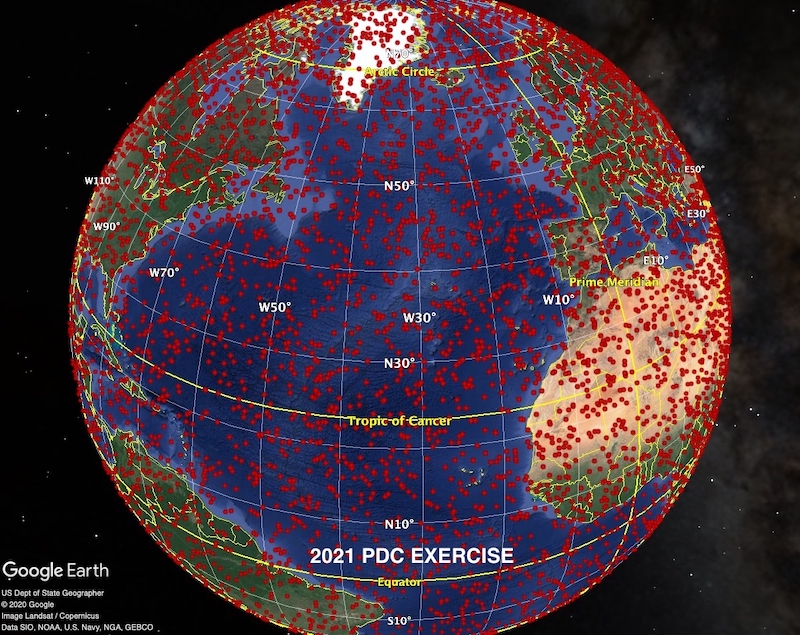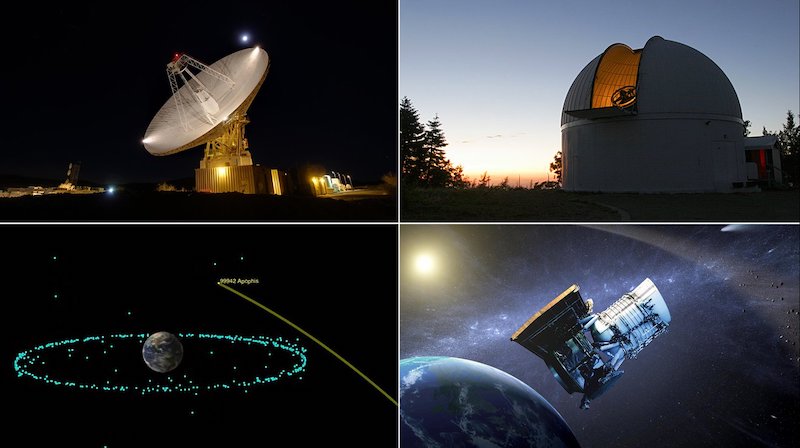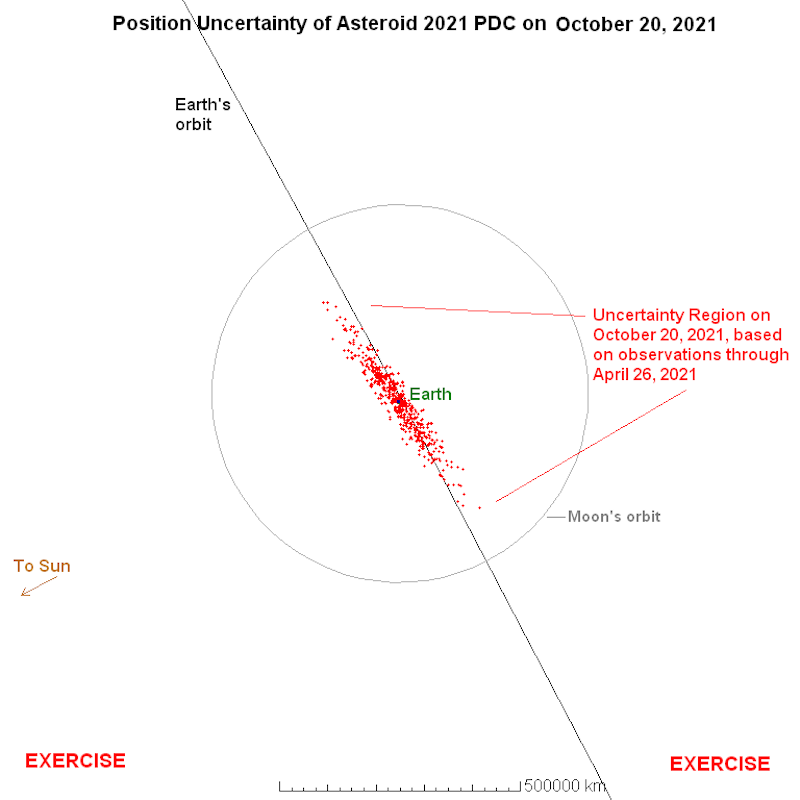
On May 31, 2022, researchers published a new paper describing the results of the latest global planetary defense exercise. which used an imaginary sweep of asteroid Apophis near Earth. At its actual closest on March 6, 2021, Apophis was 40 times the moon’s distance away. But – for purposes of the exercise – the researchers pretended it would come close enough to collide with Earth. The 2021 exercise was the 3rd of its kind. The goal is to test the operational readiness of Earth’s planetary defense capabilities against possible asteroid collisions. These community-led global exercises were carried out with the support of NASA’s Planetary Defense Coordination Office and the International Asteroid Warning Network. NASA described the most recent results, in the article reprinted below.
A planetary defense exercise
Over 100 participants from 18 countries – including NASA scientists and the agency’s NEOWISE mission – took part in an international planetary defense exercise last year using Apophis as a hazardous asteroid stand-in.
Watching the skies for large asteroids that could pose a hazard to the Earth is a global endeavor. So, to test their operational readiness, the international planetary defense community will sometimes use a real asteroid’s close approach as a mock encounter with a “new” potentially hazardous asteroid. The lessons learned could limit, or even prevent, global devastation should the scenario play out for real in the future.
To that end, more than 100 astronomers from around the world participated in an exercise last year. They essentially removed a large, known and potentially hazardous asteroid from the planetary defense-monitoring database to see whether they could properly detected it again. Not only did they “discover” the object during the exercise, they continually reassessed it as they tracked it, until they ruled out the possibility of impact.

Apophis as a stand-in
Coordinated by the International Asteroid Warning Network (IAWN) and NASA’s Planetary Defense Coordination Office (PDCO), the exercise confirmed that, from initial detection to follow-up characterization, the international planetary defense community can act swiftly to identify and assess the hazard posed by a new near-Earth asteroid discovery. A study published in the peer-reviewed Planetary Science Journal on Tuesday, May 31, details the results.
The exercise focused on the real asteroid Apophis. For a short while after its discovery in 2004, scientists assessed Apophis as having a significant chance of impacting Earth in 2029 or later. But based on tracking measurements taken during several close approaches since the asteroid’s discovery, astronomers have refined Apophis’ orbit and now know that it poses no impact hazard whatsoever for 100 years or more. The planetary defense community used scientific observations of Apophis’ most recent close approach, which occurred between December 2020 and March 2021, for this exercise.
Vishnu Reddy, associate professor at the University of Arizona’s Lunar and Planetary Laboratory in Tucson, who led the campaign, said:
This real-world scientific input stress-tested the entire planetary defense response chain, from initial detection to orbit determination to measuring the asteroid’s physical characteristics and even determining if, and where, it might hit Earth.
Tracking a ‘new’ target
Astronomers knew Apophis would approach Earth in early December 2020. But to make the exercise more realistic, the Minor Planet Center (MPC) – the internationally recognized clearinghouse for the position measurements of small celestial bodies – pretended that it was an unknown asteroid. They did this by preventing connections between the new observations of Apophis with previous observations of it. When the asteroid approached, astronomical surveys had no prior record of Apophis.
On December 4, 2020, as the asteroid started to brighten, the NASA-funded Catalina Sky Survey in Arizona made the first detection and reported the object’s astrometry (its position in the sky) to the Minor Planet Center. Because there was no prior record of Apophis for the purpose of this exercise, scientists logged the asteroid as a brand-new detection. Other detections followed from the Hawaii-based, NASA-funded Asteroid Terrestrial-impact Last Alert System (ATLAS) and Panoramic Survey Telescope and Rapid Response System (Pan-STARRS).
As Apophis drifted into the field of view of NASA’s Near-Earth Object Wide-field Infrared Survey Explorer (NEOWISE) mission, the MPC linked its observations with those made by ground-based survey telescopes to show the asteroid’s motion through the sky. On December 23, the MPC announced the discovery of a “new” near-Earth asteroid. Exercise participants quickly gathered additional measurements to assess its orbit and whether it could impact Earth.
Planetary defense rules out an impact
Davide Farnocchia, a navigation engineer at NASA’s Jet Propulsion Laboratory in Southern California, who led the orbital determination calculations for JPL’s Center for Near Earth Object Studies (CNEOS), said:
Even though we knew that, in reality, Apophis was not impacting Earth in 2029, starting from square one – with only a few days of astrometric data from survey telescopes – there were large uncertainties in the object’s orbit that theoretically allowed an impact that year.
During the asteroid’s March 2021 close approach, JPL astronomers used NASA’s 230-foot (70-meter) Goldstone Solar System Radar in California to image and precisely measure the asteroid’s velocity and distance. These observations, combined with measurements from other observatories, enabled astronomers to refine Apophis’ orbit and rule out a 2029 impact for the purpose of the exercise. (Beyond the exercise, they also were able to rule out any chance of impact for 100 years or more.)

NEOWISE homes in
Orbiting far above Earth’s atmosphere, NEOWISE provided infrared observations of Apophis that would not have been possible from the ground because moisture in the Earth’s atmosphere absorbs light at these wavelengths.
Akash Satpathy, an undergraduate student who led a second paper with NEOWISE Principal Investigator Amy Mainzer at the University of Arizona, described the results with inclusion of their data in the exercise:
The independent infrared data collected from space greatly benefited the results from this exercise. NEOWISE was able to confirm Apophis’ rediscovery while also rapidly gathering valuable information that could be used in planetary defense assessments, such as its size, shape and even clues as to its composition and surface properties.
By better understanding the asteroid’s size, participating scientists at NASA’s Ames Research Center in Silicon Valley, California, could also estimate the impact energy that an asteroid like Apophis would deliver. And the participants simulated a swath of realistic impact locations on Earth’s surface that, in a real situation, would help disaster agencies with possible evacuation efforts.

A global success
Michael Kelley, a program scientist with PDCO, within NASA’s Planetary Science Division at NASA Headquarters in Washington, who provided guidance to the exercise participants, said:
Seeing the planetary defense community come together during the latest close approach of Apophis was impressive. Even during a pandemic, when many of the exercise participants had to work remotely, we were able to detect, track, and learn more about a potential hazard with great efficiency. The exercise was a resounding success.
Additional key planetary defense exercise working group leads included Jessie Dotson at NASA Ames, Nicholas Erasmus at the South African Astronomical Observatory, David Polishook at the Weizmann Institute in Israel, Joseph Masiero at Caltech-IPAC in Pasadena and Lance Benner at JPL, a division of Caltech.
NEOWISE’s successor, the next-generation NEO Surveyor, has a launch date of no earlier than 2026 and will greatly expand the knowledge NEOWISE has amassed about the near-Earth asteroids that populate our solar system.
Click here for more information about CNEOS, asteroids and near-Earth objects.
Bottom line: In a test of planetary defense, scientists used a recent close approach of asteroid Apophis as a trial run to determine how they could quickly track and identify a hazardous space rock.
Source: Apophis Planetary Defense Campaign
Source: NEOWISE Observations of the Potentially Hazardous Asteroid (99942) Apophis
Read more: Asteroid Apophis to sweep close 7 years from now
The post Planetary defense exercise: This was only a test first appeared on EarthSky.
0 Commentaires